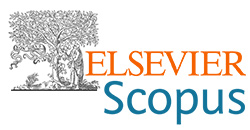Assessment of hydrogeochemical characteristics and potable quality of groundwater around Retteri lake in Thiruvallur district, Tamil Nadu, India
DOI:
https://doi.org/10.62638/ZasMat1204Abstract
Hydrogeochemical characteristics of groundwater are significantly affected by its interaction with aquifer minerals. This in turn affects the quality of groundwater for its intended usage. The objective of the present research is to identify the processes controlling the hydrogeochemical characteristics of groundwater around Retteri lake and to assess its potable quality. Ground water samples from 26 sites were collected from the study area and physicochemical analysis were performed to evaluate the water quality parameters such as pH, Electrical Conductivity(EC), Total Dissolved Solids(TDS), Total Hardness(TH), Total Alkalinity(TA), Ca2+, Mg2+, Na+, K+, Cl-, SO42-, CO32-, HCO3-and NO3-. Correlation analysis for the water quality parameters was performed to identify the nature and degree of correlation among the various parameters. A strong positive correlation was observed between pH and HCO3-. EC and TDS shows a strong positive correlation with Ca2+, Mg2+, Na+, Cl- and SO42-. TH exhibits a strong positive correlation with Ca2+, Mg2+, Cl- and SO42-. Scatter plots were drawn among major ions to identify the geogenic processes responsible for the hydrogeochemical evolution of groundwater in the study area. The Gibbs plots of the study region indicate that water-rock interaction is the major process that influences the composition of groundwater. The Piper diagram reveals that Na-Cl and mixed Ca-Mg-Cl are the major hydrochemical facies of the groundwater in the study region. The potable quality of groundwater was examined through the evaluation of water quality index (WQI) by weighted arithmetic method. The WQI calculations reveals that 19% samples of groundwater are of excellent quality, 62% samples are of good quality and 19% samples are of poor to very poor quality.
Keywords:
Scatter plot, water quality index, groundwater, total dissolved solids, total hardness andtotal alkalinityReferences
Han, D., Song, X., Currell, M., Cao, G., Zhang, Y., & Kang, Y. (2011). A survey of groundwater levels and hydrogeochemistry in irrigated fields in the Karamay Agricultural Development Area, northwest China: implications for soil and groundwater salinity resulting from surface water transfer for irrigation. Journal of Hydrology, 405(3–4), 217–234. https://doi.org/10.1016/j.jhydrol.2011.03.052.
Li, P., & Qian, H. (2018). Water resource development and protection in loess areas of the world: a summary to the thematic issue of water in loess. Environmental Earth Sciences, 77(24), 796. https://doi.org/10.1007/s12665-018-7984-3.
Zhang, Q., Qian, H., Xu, P., Hou, P., & Yang, F. (2021). Groundwater quality assessment using a new integrated-weight water quality index (IWQI) and driver analysis in the Jiaokou Irrigation District, China. Ecotoxicology and Environmental Safety, 212, 111992. https://doi.org/10.1016/j.ecoenv.2021.111992.
West, L. J., & Odling, N. E. (2014). Groundwater. In Water Resources (pp. 123–160). Routledge. https://doi.org/10.4324/9780203489413.
Krishna Kumar, S., HariBabu, S., Eswar Rao, P., Selvakumar, S., Thivya, C., Muralidharan, S., & Jeyabal, G. (2017). Evaluation of water quality and hydrogeochemistry of surface and groundwater, Tiruvallur District, Tamil Nadu, India. Applied Water Science, 7(5), 2533–2544. https://doi.org/10.1007/s13201-016-0447-7.
Patrick, P. L., & Arnold, W. A. (2022). Water Chemistry. Oxford University Press, New York.
Cheng, A. H. (2000). Multilayered Aquifer Systems: Fundamentals and Applications. CRC Press.
APHA (2022). Standard methods for the examination of water and wastewater (24th edn.). American Public Health Association, Washington.
BIS (2012). Bureau of Indian Standards drinking water – Specification (second revision) IS 10500.
Horton, R. K. (1965). An index number system for rating water quality. Journal of Water Pollution Control Federation, 37(3), 300–305.
Chaurasia, A. K., Pandey, H. K., Tiwari, S. K., Prakash, R., Pandey, P., & Ram, A. (2018). Groundwater quality assessment using water quality index (WQI) in parts of Varanasi District, Uttar Pradesh, India. Journal of the Geological Society of India, 92(1), 76–82. https://doi.org/10.1007/s12594-018-0955-1.
Agarwal, M., Singh, M., & Hussain, J. (2020). Evaluation of groundwater quality for drinking purposes using different water quality indices in parts of GautamBudh Nagar District, India. Asian Journal of Chemistry, 32(5), 1128–1138. https://orcid.org/0000-0003-3595-750X.
Shroff, P., Vashi, R. T., Champaneri, V. A., & Patel, K. K. (2015). Correlation study among water quality parameters of groundwater of Valsad district of south Gujarat (India). Journal of Fundamental and Applied Sciences, 7(3), 340–349. http://dx.doi.org/10.4314/jfas.v7i3.3.
Mohammad, A. D., & Rind, R. F. (2020). An Application of WQI and Correlation Matrix to Evaluate Groundwater Quality Around Brick Kilns of Loralai District Balochistan. Journal of Asian Scientific Research, 10(2), 88–95. https://doi.org/10.18488/journal.2.2020.102.88.95.
Ravikumar, P., & Somashekar, R. K. (2017). Principal component analysis and hydrochemical facies characterization to evaluate groundwater quality in Varahi river basin, Karnataka state, India. Applied Water Science, 7(2), 745–755. https://doi.org/10.1007/s13201-015-0287-x.
Piper, A. M. (1944). A graphic procedure in the geochemical interpretation of water-analyses. Eos, Transactions American Geophysical Union, 25(6), 914–928. https://doi.org/10.1029/TR025i006p00914.
Zaporozec, A. (1972). Graphical interpretation of water-quality data. Groundwater, 10(2), 32–43. https://doi.org/10.1111/j.1745-6584.1972.tb02912.x.
Elango, L., & Kannan, R. (2007). Rock–water interaction and its control on chemical composition of groundwater. Developments in Environmental Science, 5, 229–243. https://doi.org/10.1016/S1474-8177(07)05011-5.
Gibbs, R. J. (1970). Mechanisms controlling world water chemistry. Science, 170(3962), 1088–1090. https://doi.org/10.1126/science.170.3962.1088.
Marandi, A., & Shand, P. (2018). Groundwater chemistry and the Gibbs Diagram. Applied Geochemistry, 97, 209–212. https://doi.org/10.1016/j.apgeochem.2018.07.009.
Rao, N. S., Sunitha, B., Sun, L., Spandana, B. D., & Chaudhary, M. (2020). Mechanisms controlling groundwater chemistry and assessment of potential health risk: a case study from South India. Geochemistry, 80(4), 125568. https://doi.org/10.1016/j.chemer.2019.125568.
Li, P., Wu, J., & Qian, H. (2013). Assessment of groundwater quality for irrigation purposes and identification of hydrogeochemical evolution mechanisms in Pengyang County, China. Environmental Earth Sciences, 69, 2211–2225. https://doi.org/10.1007/s12665-012-2049-5.
Wu, J., Li, P., Qian, H., Duan, Z., & Zhang, X. (2014). Using correlation and multivariate statistical analysis to identify hydrogeochemical processes affecting the major ion chemistry of waters: a case study in Laoheba phosphorite mine in Sichuan, China. Arabian Journal of Geosciences, 7, 3973–3982. https://doi.org/10.1007/s12517-013-1057-4.
Li, P., Wu, J., Qian, H., Zhang, Y., Yang, N., Jing, L., & Yu, P. (2016). Hydrogeochemical characterization of groundwater in and around a wastewater irrigated forest in the southeastern edge of the Tengger Desert, Northwest China. Exposure and Health, 8, 331–348. https://doi.org/10.1007/s12403-016-0193-y.
Li, P., Wu, J., & Qian, H. (2016). Hydrochemical appraisal of groundwater quality for drinking and irrigation purposes and the major influencing factors: a case study in and around Hua County, China. Arabian Journal of Geosciences, 9, 1–17. https://doi.org/10.1007/s12517-015-2059-1.
Adimalla, N., Li, P., & Venkatayogi, S. (2018). Hydrogeochemical evaluation of groundwater quality for drinking and irrigation purposes and integrated interpretation with water quality index studies. Environmental Processes, 5, 363–383. https://doi.org/10.1007/s40710-018-0297-4.
Ren, X., Li, P., He, X., Su, F., & Elumalai, V. (2021). Hydrogeochemical processes affecting groundwater chemistry in the central part of the Guanzhong Basin, China. Archives of Environmental Contamination and Toxicology, 80, 74–91. https://doi.org/10.1007/s00244-020-00772-5.
Krishna Kumar, S., Logeshkumaran, A., Magesh, N. S., Godson, P. S., & Chandrasekar, N. (2015). Hydro-geochemistry and application of water quality index (WQI) for groundwater quality assessment, Anna Nagar, part of Chennai City, Tamil Nadu, India
Khan, F., Krishnaraj, S., Raja, P., Selvaraj, G., & Cheelil, R. (2021). Impact of hydrogeochemical processes and its evolution in controlling groundwater chemistry along the east coast of Tamil Nadu and Puducherry, India. Environmental Science and Pollution Research, 28(15), 18567–18588. https://doi.org/10.1007/s11356-020-10912-y.
Gao, Z., Han, C., Xu, Y., Zhao, Z., Luo, Z., & Liu, J. (2021). Assessment of the water quality of groundwater in Bohai Rim and the controlling factors—a case study of northern Shandong Peninsula, north China. Environmental Pollution, 285, 117482. https://doi.org/10.1016/j.envpol.2021.117482.
Das, T. K., Shaibur, M. R., & Rahman, M. M. (2021). Groundwater chemistry at deep aquifer in Koyra: Khulna, Bangladesh. Current World Environment, 16(2), 460. https://doi.org/10.12944/CWE.16.2.12.
Bahir, M., El Mountassir, O., Ouazar, D., & Carreira, P. M. (2021). Hydrochemical analysis and evaluation of groundwater quality in Ouazi Basin (Essaouira, Morocco). In Advances in Geoethics and Groundwater Management: Theory and Practice for a Sustainable Development (pp. 247–250). Springer, Cham. https://doi.org/10.1007/978-3-030-59320-9_50.







